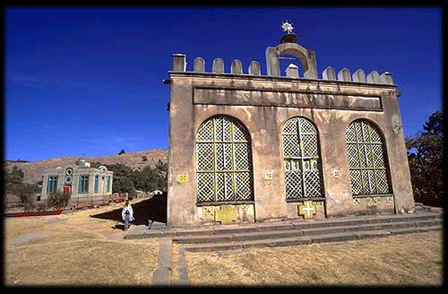Ark of the Govenant
The Ark of the Covenant is also known as the "Ark of the Testimony” because the Ten Commandments were a testimony to the world of the covenant God made with Israel. When the Ark was in the Tabernacle, it contained the golden pot that had manna, Aaron’s rod that budded and the second set of stone tablets on which the Ten Commandments were written by God. After the Ark came to rest in the Temple, it contained only the two tablets of stone.
While at Mount Sinai, Moses was given instructions for building the Ark of the Covenant. God had directed Moses to use Bezalel and Oholiab to make the Ark of the Covenant.
Mount Sinai in Egypt
The Ark of the Covenant was made of shittim wood, a species of the Acacia, which is said by many to be imperishable.
.png)
Acacia Tree in the Negev Desert of Southern Israel
It was 45 inches long, 27 inches wide, and 27 inches high overlaid inside and outside with pure gold. A crown of gold formed the top of its sides that would support the Mercy Seat and prevent it from slipping off. The Ark had to be moved occasionally and since men were not to touch it, four gold rings were attached to its four feet, two rings on each side. Staves of shittim wood overlaid with gold were inserted into the rings to carry it. The staves had to stay inside the rings and never be removed.
.png)
Ark of the Covenant Model
Ark’s cover (Mercy Seat) was a solid sheet or slab of pure gold, 45 inches long and 27 inches wide. At either end of it was a cherub, not fastened thereto, but beaten out of the same one piece of gold of which the Mercy Seat was formed. The cherubim had their wings outstretched, thus overshadowing the Mercy Seat, with their faces looking down upon it. An important aspect of the Ark is that God told Moses that He will meet and speak to him from between the two cherubim that are over the Ark of the Testimony.
One of the strongest claims about the Ark's whereabouts is that, it had found its way to Ethiopia, where it still resides in the town of Aksum, in the St. Mary of Zion cathedral. Church authorities, however, say only one man, the guardian of the Ark, is allowed to see it, and they have never permitted it to be studied for authenticity.

The Old Church of St. Mary of Zion with the Treasury Containing the Ark of the Covenant in the Background (left)
Another claim is that the Ark was hidden in a warren of passages beneath the First Temple in Jerusalem before the Babylonians destroyed it in 586 B.C. But that theory can't be tested either, because the site is home to the Dome of the Rock shrine, sacred in Islam.

Dome of the Rock Shrine in Jerusalem

Mount Sinai Near Saint Catherine in the Sinai Region
.png)
